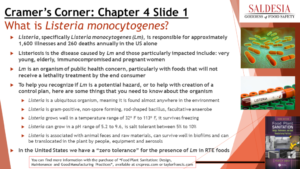What is Listeria monocytogenes?


The ability to control Listeria in the food manufacturing environment begins with understanding the organism and its’ growth needs. These are presented in Cramer’s Corner Chapter 4 Slide 1, and in more detail in Chapter 4 of the book Food Plant Sanitation, entitled “Control of Listeria in Food Manufacturing”.”
Slide Content
Listeria, specifically Listeria monocytogenes (Lm), is responsible for approximately 1,600 illnesses and 260 deaths annually in the US alone
Listeriosis is the disease caused by Lm and those particularly impacted include: very young, elderly, immunocompromised and pregnant women
Lm is an organism of public health concern, particularly with foods that will not receive a lethality treatment by the end consumer
To help you recognize if Lm is a potential hazard, or to help with creation of a control plan, here are some things that you need to know about the organism
– Listeria is a ubiquitous organism, meaning it is found almost anywhere in the environment
– Listeria is gram-positive, non-spore forming, rod-shaped bacillus, facultative anaerobe
– Listeria grows well in a temperature range of 32⁰ F to 113⁰ F, it survives freezing
– Listeria can grow in a pH range of 5.2 to 9.6, is salt tolerant between 5% to 10%
– Listeria is associated with animal feces and raw materials, can survive well in biofilms and can be translocated in the plant by people, equipment and aerosols
In the United States we have a “zero tolerance” for the presence of Lm in RTE foods
